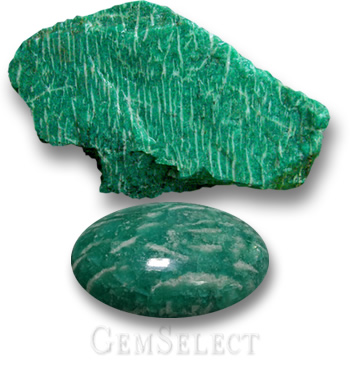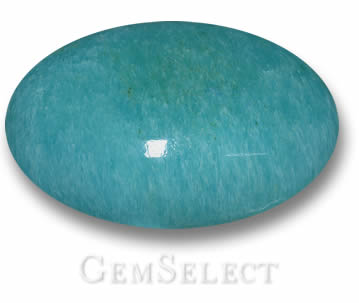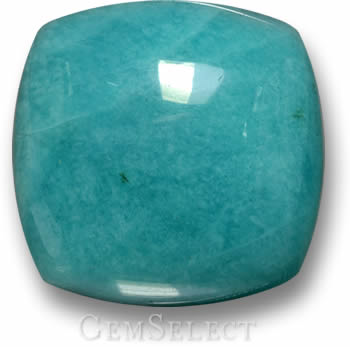|
Reviewed By Andreas Zabczyk
Amazonite Locations
Amazonite Rough and Cut
The most common minerals in the world are the feldspars, which make up nearly 60% of the Earth's crust. Given the ubiquity of feldspar, it is somewhat surprising that there are so few feldspar gemstones. By contrast, another very common mineral, quartz, has at least a dozen well-known gemstone varieties, including amethyst, citrine, tiger's eye, chalcedony and agate. There are two main subgroups of feldspar that produce gem-quality material; the potassium feldspars and the plagioclases, a series that ranges from calcium to sodium feldspars. Among the feldspar gemstones are moonstone, orthoclase, amazonite, andesine, labradorite and sunstone. Amazonite, moonstone and orthoclase are all potassium feldspars. They have a hardness of 6 to 6.5 on the Mohs scale, and a vitreous luster. Moonstone is a very well-known gemstone, but orthoclase and amazonite are not. 
Oval Amazonite Cabochon
Amazonite is a type of green microcline gemstone. Despite its name being derived from the Amazon River in Brazil, no deposits of this gemstone have been discovered in that region. Legend has it that green stones were found in the Amazon River area, but mineralogists argue that there is no green feldspar present in that specific location, although deposits can be found elsewhere in Brazil. The lively green or blue-green color of amazonite can be quite beautiful when polished. Since amazonite is an opaque stone, it is usually fashioned as cabochons. It is a medium-hard material, rating 6 to 6.5 on the Mohs scale, so it is not ideally suited to rings. But it makes very attractive earrings and pendants. 
Cushion-Shaped Amazonite Cabochon
For many years, the source of amazonite's color was a mystery. Many people assumed the color was due to traces of copper because copper compounds often have blue and green colors. More recent studies suggest that the blue-green color results from small quantities of lead and water in the feldspar. Amazonite is found in relatively few locations in the world. At one time it was found almost exclusively in the Ilmen mountains of Russia. More recently, deposits have been found in the USA (Colorado), Brazil and Madagascar. Amazonite is believed to possess various meanings and healing properties. This gemstone is often associated with soothing and calming energies, promoting harmony and balance in one's life. It is said to help alleviate stress and anxiety, encouraging a sense of inner peace and tranquility. Amazonite is also thought to enhance communication and creativity, aiding in expressing oneself more effectively and fostering inspiration. Additionally, this gemstone is believed to promote physical healing, particularly in issues related to the throat, heart, and nervous system. Overall, Amazonite is considered a stone of hope, truth, and empowerment, offering support in times of need and promoting overall well-being. This Page in Other Languages
|
| STAY IN TOUCH | NEWSLETTER |
| *You're signing up to receive GemSelect promotional email. |
Copyright © 2005-2024 GemSelect.com all rights reserved.
Reproduction (text or graphics) without the express written consent of GemSelect.com (SETT Company Ltd.) is strictly prohibited.
565